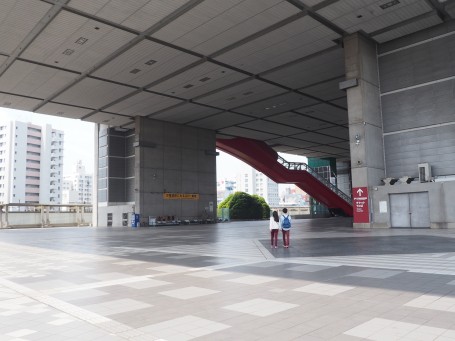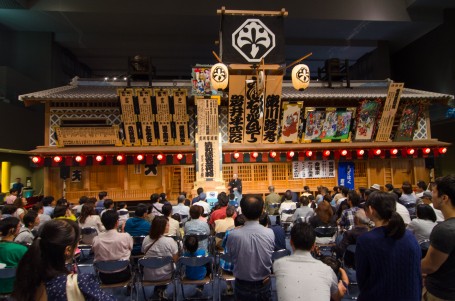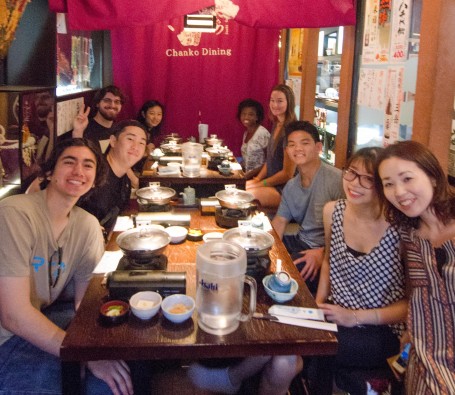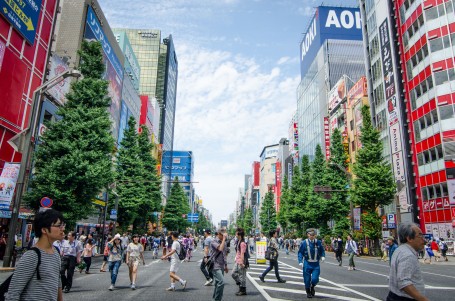By: Grant Yoneoka
Sunday the 29th, and it is a sunny and bright day. We were definitely more rested than the day before, and I think most of us were starting to adjust well to the local time here in Tokyo. We began our day bound for the Edo-Tokyo museum, which is this futuristic looking and monolithic structure in the middle of Tokyo. Inside the museum was quite interesting and contained a wide collection of Tokyo’s history spanning from very ancient times all the way into World War II and the modern era.
During our stay, a very enthusiastic tour guide led us around the museum and gave us a lot of background history as well. We learned that the reason the museum is called the Edo-Tokyo museum is because Tokyo was once called Edo back in Japan’s feudal era. We also learned a lot about the Edo (or Tokugawa) period and how the Shogun and his Daimyos (feudal lords) ruled Japan with relative stability for 300 years through a system of social and economical hierarchy. The tour was very interesting and offered an intricate overview of Tokyo’s history. Towards the end, we got also to see a little glimmer of traditional Japanese entertainment through the art of koma (spinning tops). I thought it was really nice to see that there are still people who try to preserve traditional Japanese culture, and I can definitely see how Tokyo, more than most modern cities, is a real cosmopolitan of both traditional and modern culture and values.
After our visit to the museum, we made our way to a chankonabe restaurant for lunch, which was located very close to Ryōgoku Kokugikan (Tokyo’s famous sumo wrestling hall). Chankonabe is basically sumo wrestler food and is a stew made out of different types of meats and vegetables. I suppose you could call it kind of a concoction of foods, but it was done in a way that all of the flavors complemented each other, and it was quite delicious.
Our last destination together that day, and perhaps the strangest, was Akihabara, or the electric city. Akihabara is really famous for its electronic, manga, and anime scene, and it is really a bustling place. They even closed the streets that day (they close the streets every Sunday in fact) so that pedestrians could walk through the district without worrying about incoming traffic. While we were there, we visited a maid café, which was a very bizarre experience. All of the workers there were young girls dressed up as cute maids. The place itself reminded me of something straight out of Disneyland, and it was definitely a very unique environment. Most of us ordered drinks like coffee or milkshakes, and I was surprised to find out that the maids even drew a picture of whatever we wanted inside of our drinks with syrup. After we were done, a lot of us left to go explore Tokyo on our own.
I spent the rest of the day browsing through the streets of Ueno and the nearby park. Ueno itself kind of reminded me of Korea town in Los Angeles. There was a lot going on and the place just seemed so alive. The backstreets of Ueno was mostly filled with clothing shops and the like, and it was very easy to get immersed in all of the action. I tried not to stay long, however, because I did not want to spend all of my money on clothes. As the sun started to set, I decided to spend the last few hours browsing through Ueno park.
My first impression of the park was that it was absolutely huge. It contained a pond filled with lotuses, temples, amusement park, and even a zoo complete with a panda. There was also a bonsai festival which showcased many different bonsai trees along with various foods from around Japan. I thought it was really cool to see how interactive everyone was and how people were not afraid to explain things, even if it meant speaking in English. By the time I was done exploring the festival, the sun was almost done setting, and I decided to call it a day. Although it was only our second full day here, I think we saw and experienced a ton, and we were definitely excited to meet the Meiji students the next day.






